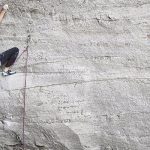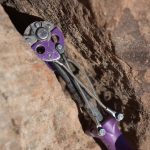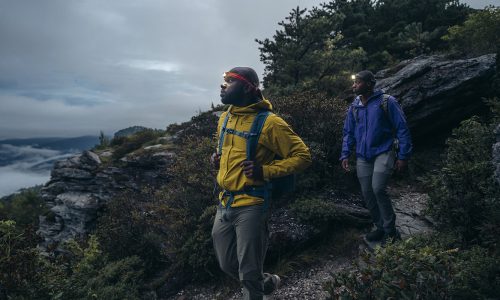Home » Gear Reviews » Climbing » Climbing Cams » Omega Pacific Link Cams
Omega Pacific Link Cams Review
May 15, 2018



















 72
72 The Good
- Widest camming range on the market
- Good “crux” piece when unsure of size
- Great for building gear anchors
- Will work in flared placements
The Bad
- Heavy compared to other cams
- Poor ergonomics
- Less stable than other cams
- Durability issues with cam lobes and stems
- Expensive
Ergonomics
The Link Cams have a simple thumb piece where the sling is threaded and stitched and a long and slightly textured trigger bar to provide grip when racking or cleaning. Many testers found cams with thumb loops to be friendlier to use and the lack of a thumb loop on the Link Cams was noted. The thumb piece in lieu of a thumb loop is the smallest out of the thumb pieces on cams tested and while it has some texture to it to help provide purchase, the small surface area and lack of a contour or curve to it was a drawback.
Stability
The Link Cams’ unique trisected cam lobe allows the Link Cams to be placed in a far wider range of sizes than any other cams. In terms of stability, where in this wide range the Link Cams was placed often affected its stability. In a more open range the Link Cams were prone to “walking” or moving farther into a crack. This problem is an age old problem with cams that can lead to cams getting stuck or hard to reach with all but the tiniest of fingers. During both field testing and in house testing the Link Cams were more stable when placed with a tighter fit but they are also more prone to getting stuck. The relatively short sling and the way it’s tightly stitched into the stem also limited movement of the sling, thus affecting the stability of the cam placement and promoting walking or movement of the cam, relative to other cams tested.
Durability
Link Cams may suffer from some concerns about durability. The trisected cam lobes are made from steel for the first two cam lobes and aluminum for the third. In the field we’ve observed many of these outer, aluminum lobes broken from attempts to free stuck Link Cams. Perhaps owing in part to their poor stability compared to other cams on the market, leading Link Cams to become stuck has caused them to be jokingly referred to as “fixed cams”. It’s perhaps telling that Omega Pacific has detailed instructions about proper placement to avoid damage to the cams. Any cam can become damaged during falls or use, particularly when not placed in the direction of fall. While the cams we extensively tested weren’t damaged during testing we observed many Link Cams outside of our testing which have suffered an early demise. Additionally, the Link Cam stems were found to be less flexible than most of the cams tested, other than the Black Diamond Ultralight Camalots. As a result, they appeared more prone to damage when loading over an edge, such as in a horizontal placement. While they generally would return to form after manipulation it did raise the question of their overall durability. One area where the Link Cam shone in terms of durability were the braided cables used for the trigger wires. Coating in some form of plastic they never showed sign of fraying, kinking or damage during testing.
Versatility
The climbers and testers who didn’t favor Link Cams tended to cite issues with durability and their weight. The weight can be an issue when ounces count on a long route or a day in the mountains. That being said, Link Cams were favored by many testers when they were headed into the alpine for an objective where only a few cams would be needed and the wide range of the Link Cams can come in handy. While the Link Cams may have great range, it’s still just four cams in the set and if you need 12 or 16 cams for a route that weight can add up and demonstrate a limitation for Link Cams. They can be heavy if you are going to only rack Link Cams for a big route. But, many climbers and testers found them useful as an addition to a rack where they could count on having a few Link Cams to give wide options for building gear belays or a “crux piece” that is easy to grab and place quickly when in a tricky spot. For example, often when climbing desert sandstone splitters climbers run into crack sizes that are in between two cam sizes so one size is tipped out and one size is really tight. The Link Cams can bridge that gap between sizes. So while they may not be a standalone cam to build a rack with they can be a nice compliment to a rack. For aid climbing, the lack of a thumb loop to clip in short was a negative for many testers but their relatively short sling along with their wide camming range and ability to work reasonably well in flared placements gave them mixed appeal for the aid climbing crowd.
Features
The standout feature on the Link Cams are the unique trisected cam lobe design where the cam lobes have mini axles, of sorts, on each of them, allowing them to retract as the trigger is pulled, providing a far wider cam range than any other cam on the market. The 2.5:1 camming ratio gives the Link Cams great advantage over other cams to fit a really wide spectrum. Hence, they can come in handy when you only need to a few pieces for a route but aren’t sure which exact sizes. Or, they can give you a lot of options when getting to a gear belay and you’re searching for anchoring options with your remaining gear after leading a pitch. Or, they can be a handy piece to grab for a crux on a climb when you really want to get something in but don’t want to fumble around with trying different cams to find the right size. The Link Cams are built with Metal-Injection-Molding and rather than being made from one material, the two inner links are made with 17-4 aircraft stainless steel while the outer link is made from 7000-series aluminum alloy.
Weight
At 95 grams (3.35 ounces) for the .5 size (purple), the Link Cams are the heaviest in this round of testing. The four available Link Cams together weigh 20.85 ounces. By comparison, four comparable Metolius Ultralight Master Cams weigh 12.8 ounces. That half pound difference is noticeable. While the Link Cams may have greater range it’s still four cams in the set and if you need 8, 12, or 16 cams for a route that weight adds up, limiting the appeal of the Link Cams when considering weight.
Sizes Available w/ Strength Rating, Range and Weight:
.5 – 8 kN – 13.5-35 mm (.53-1.38″) – 95 grams (3.35 ounces)
.75 – 10 kN – 17.8-44.5 mm (.70-1.75”) – 113 grams (4 ounces)
1 – 14 kN – 21.1-53.3 mm (.83-2.10”) – 176 grams (6.2 ounces)
2 – 14 kN – 25.4-64 mm (.96-2.51”) – 207 grams (7.3 ounces)
These cams went through a number of in-house tests for controlled and measurable metrics and were used by a number of climbers in the field with varying experience levels and interests. Their feedback provided the information to best understand how each cam performed. We spent a lot of time climbing single pitch cracks but an equal amount of time climbing multi-pitch routes in the mountains or in the desert. We paid close attention to how cams handled when being placed or cleaned and by various climbers to gain a sense of each cam’s ergonomics and ease of handling. We looked for signs of walking and stability when placing cams in various cracks of all different sizes.
Schneiter is an AMGA-certified guide, founder of Glenwood Climbing Guides, and very quick on his draws.


















